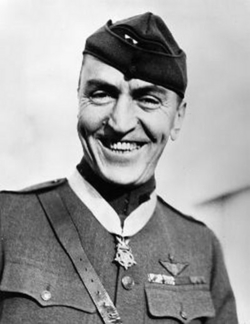Monuments
Lafayette and Cigognes Squadrons Airfield WWI pilots
Rouze Main Camp/Airfield Information Sign, WW1

World War I Congressional Medal of Honor Recipient, Distinguished Service Cross Recipient, Fighter Ace, Aviator, Race Car Driver, America's 'Ace of Aces' during World War I. The son of Swiss immigrants, Rickenbacker first gained fame driving race cars. Due to his mechanical prowess, he started the war as an engineering officer and almost wasn't allowed to become a pilot. However, once he found himself and his unit a competent replacement, he was awarded a place in the 94th Aero Squadron, the famous “Lafayette Escadrille”. Here, he would become a legend. On April 29, 1918, he shot down his first plane and earned his first Distinguished Service Cross. Five months later, now a Captain, he commanded the squadron. The following month he recorded his final kill of his 26 official victories scored in the war, the highest record for an American pilot. His 7 Distinguished Service Crosses have never been equaled. He also was awarded the French Croix de Guerre. Incredibly, he earned 5 DSCs in the same month and 2 DSCs on consecutive days. He survived the war and in 1931 an eighth DSC was upgraded by the War Department to the Medal of Honor. In October 1942, he was aboard a B-17 bomber on a secret mission in the Pacific, when it crashed, and he and six others spent 24 days afloat on life rafts. The following year he traveled on another mission for the War Department, this time to the U.S.S.R. His civilian accomplishments include creating Eastern Airlines, the renaming of Rickenbacker Air Force Base in his honor, and induction into the Motorsports Hall of Fame of America. He also has his own stamp. But his greatest achievement was his MOH, of which the citation reads: "Edward V. Rickenbacker, Colonel, specialist reserve, then first lieutenant, 94th Aero Squadron, Air Service, American Expeditionary Forces. For conspicuous gallantry and intrepidity above and beyond the call of duty in action against the enemy near Billy, France, September 25, 1918. While on a voluntary patrol over the lines Lt. Rickenbacker attacked seven enemy planes (five type Fokker protecting two type Halberstadt photographic planes). Disregarding the odds against him he dived on them and shot down one of the Fokkers out of control. He then attacked one of the Halberstadts and sent it down also."
From the National Veterans Memorial Museum:
Less than two miles east of the National Veterans Memorial and Museum, at 1334 East Livingston Avenue in Columbus, Ohio, sits an unassuming wood framed house with a small historical marker that is easy to miss. It is the childhood home of a true American hero and Columbus native, Captain Eddie Rickenbacker. His story, one of hundreds told throughout the National Veterans Memorial and Museum, is inspirational and legendary.
After surviving several near-death experiences during an accident-prone childhood, young Eddie Rickenbacker believed his life was reserved for a greater purpose. Growing up in Columbus, he preferred hands-on training and self-taught engineering to formal schooling, spending time as an apprentice with the Columbus Buggy Company (Presently “The Buggy Works,” a residential development) and later with the Duesenberg Motor Company of Iowa, a manufacturer of race cars.
Most are aware of Captain Rickenbacker’s legendary accomplishments during his military service. Despite a lack of significant formal education, he persuaded Army leadership to allow him to train as one of the first pursuit pilots. A former race car driver, he was to convert his legendary courage and aggressiveness into one of the most successful careers in military history as a fighter ace. His 26 confirmed kills during WWI, a result of repeatedly attacking enemy aircraft alone or outnumbered, was a record that stood until the later part of WWII. He received the Congressional Medal of Honor and a record eight Distinguished Service Crosses, as well as the Legion of Honor and the Croix de Guerre by France. Few among us are capable of becoming a race car driver or fighter pilot. He was both. But his heroism extended beyond his military service.
Captain Eddie (He was a Major when discharged but preferred to be called “Captain Eddie” the rest of his life) was actually declared dead by the press twice (In an early example of “fake news”) after leaving the service. In 1941 he was critically injured in a civilian airline crash, with injuries so severe, he lay untreated for several hours while others received medical attention since doctors considered his wounds fatal. Despite his severe injuries, he encouraged other survivors to persevere and seek assistance.
Shortly afterward, still suffering from his previous injuries, he was a passenger in a B-17 that was forced to ditch in the Pacific Ocean. All but one of the passengers were rescued 24 days after being adrift at sea. Survivors, all suffering from hyperthermia, sunburn, dehydration and near starvation, credit Captain Eddie’s leadership and calm demeanor under horrible conditions for their survival. He went on to serve his country in various capacities and later founded Eastern Airlines.
You can almost see Greenlawn Cemetery, where Captain Eddie Rickenbacker lies in rest, from the roof of the National Veterans Memorial and Museum. If not for a few buildings, Captain Eddie’s grave would be visible.
A former boss of mine once told me, “Leadership is easy when no one is shooting at you.” I suspect Captain Eddie might agree.
